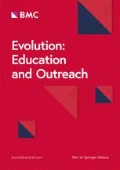The millions of species on our earth are connected to each other through complex webs of interaction that Darwin called the entangled bank. Every species has competitors, parasites, and predators, and all complex organisms rely upon mutualistic interactions with one or more other species. As these species interact, they impose natural selection on each other, producing the process of reciprocal selection that we call coevolution.
The first major tests of natural selection following publication of The Origin of Species involved coevolved interactions. Naturalists tried to understand how selection could have shaped the traits of interacting pollinators and plants. They also tried to figure out how selection could have molded the traits of distasteful and palatable butterflies that have converged on the color patterns that warn or deceive predators about their toxicity or distastefulness. The words symbiosis, mutualism, and commensalism were all coined with their biological meanings in the decades after publication of the Origin. Darwin himself spent the years immediately following the Origin studying how the exquisite variation found among orchid species could have resulted from interactions with pollinators, providing us with the first model of the coevolutionary process. He meticulously probed how natural selection on floral parts could have altered the shapes of orchid flowers time and again, using the same parts in different ways in different species.
Coevolved adaptations are often astonishingly complex, but they are not like perfectly matched machines. Because the coevolutionary process is relentless, coevolved traits are sometimes mismatched, and the mismatching varies among populations, as you would expect of an ongoing evolutionary process. Parasite populations are ahead of the coevolutionary race in some places, but the host populations are ahead in other places. As Darwin knew, the imperfections in the traits of species provide some of the best evidence that life on earth has evolved rather than formed through special creation.
Coevolution has become a major topic in evolutionary biology in recent years. This special issue on coevolution includes articles chosen to illustrate the diversity of approaches in current coevolutionary research. These papers summarize the insights we have gained from these studies. The articles probe how competitors coevolve with each other, how coevolution with parasites can favor sexual reproduction over asexual reproduction, how coevolution can vary geographically and exhibit coevolutionary hotspots and coldspots, and how the coevolutionary process may have shaped some larger patterns in the diversification of life. Other articles explore how coevolution proceeds with remarkable speed in laboratory microcosms, how mutualistic species may coevolve in ways that result in complementary traits that differ from place to place, and how interactions may generate a coevolutionary vortex that draws in more species and form webs of life with predictable structure.
We hope these articles illustrate how much we have learned in recent years about coevolution. We also hope these articles provide teachers with a concise set of current hypotheses and results about the coevolutionary process. There is still much to learn, but the science of coevolutionary biology is moving forward quickly as we continue to probe deeper into the mechanisms of reciprocal evolutionary change within the web of life.
Author information
Authors and Affiliations
Corresponding author
Rights and permissions
Open Access This article is distributed under the terms of the Creative Commons Attribution 2.0 International License (https://creativecommons.org/licenses/by/2.0), which permits unrestricted use, distribution, and reproduction in any medium, provided the original work is properly cited.
About this article
Cite this article
Thompson, J.N., Medel, R. Coevolution and the Web of Life. Evo Edu Outreach 3, 6 (2010). https://doi.org/10.1007/s12052-009-0198-0
Published:
Issue Date:
DOI: https://doi.org/10.1007/s12052-009-0198-0

